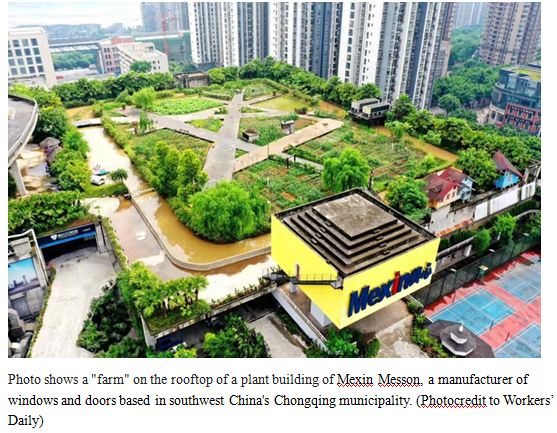By Chang Biluo, People’s Daily
It’s hard to imagine that a factory has a “farm” on its rooftop, but this is happening in the plant of Mexin Messon Doors Industry Co., Ltd, a manufacturer of windows and doors based in southwest China’s Chongqing municipality.
The rooftop “farm” covers over 20,000 square meters, where employees of the factory can grow vegetables, fruits, cereals and flowers in their off time. When the rain stops, there is a mixed fragrance of plants. The window and door manufacturer was recognized as a national-level green factory in 2019.
A green factory, according to an evaluation guideline implemented by China in 2018, features intensive land use, adopts hazard-free raw materials, practices clean production, recycles waste and employs low-carbon energy.
As a major manufacturing hub, Chongqing has vigorously promoted green transition among its enterprises. According to a plan of the municipality, Chongqing will be home to over 30 green industrial parks and 300 green factories at municipal level and above by 2025, and it will strive to lower the energy consumption per unit of value added of enterprises above designated size by 14.5 percent from 2020.
Manufacturers in Chongqing have been “gardenizing” their factories over the recent years. In the general assembly base of China State Shipbuilding Corporation Haizhuang Windpower Co., Ltd. in Chongqing’s Liangjiang New Area, trees and flowers can be seen everywhere, and there are even ponds. The vegetation cover helps the base maintain a sound ecology, always keeps it in appropriate temperature, and reduces the noise diffusion.
Industrial enterprises in the municipality have spared no effort to cut energy consumption and promote green development. They have managed to make full use of sunlight to reduce electricity consumption, greened their plant buildings to consume less energy, and adopted shock absorption and noise insulation techniques to make production quieter.
How could green transition measures be implemented while production remains non-stop? Chongqing’s answer is to lower energy consumption and improve efficiency.
“Clinker calcination is a key part of cement production,” said Han Wei, assistant manager of a cement producer in Bishan district of Chongqing. Coal is the major fuel for calcination, if traditional equipment, techniques and materials were employed during the process, it would consume high energy and lead to pollution, Han noted.
Over the recent years, Han’s company has managed to replace part of the limestone needed in the production with calcium carbonate and calcium oxide, which reduces the emission of carbon dioxide generated in the secondary combustion of limestone. This procedure alone lowers the company’s cost by over 8 million yuan ($1.16 million) each year.
Relying on big data and intelligent technologies, green enterprises in Chongqing have gradually realized targeted management of energy.
Chongqing Sokon Powertrain Co., Ltd. has a national-level green factory in Changshou Economic and Technological Development Area. “We adopt engine cold test technologies which allow us to obtain over 1,000 parameters of an engine without starting it. This cuts annual carbon dioxide emissions by more than 600 tons,” said Li Ping with the company.
To make innovations of green products through efficient utilization of energy resources remains another important approach to energy conservation and efficiency improvement.
A workshop of Chinese home appliance giant Gree in Jiulongpo district has worked to tackle technological bottlenecks and lowered its annual energy consumption by 20 percent. “Fuyao,” the first deep-sea floating wind power equipment of China rolled off the production line last year. With a single-unit capacity of 6,250 kW, the equipment is able to supply 30,000 households with clean electricity.
Many enterprises in Chongqing have started greening themselves and building green factories to further improve their performance and profit. Circular production of enterprises, circular combination of industries and circular upgrading of industrial parks are advancing vigorously in the city.













